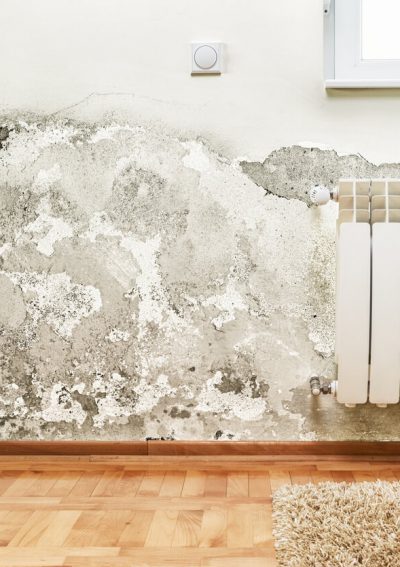Mold
Mold is a form of fungus that occurs naturally in the environment. Mold contamination in homes may cause health problems including allergic reactions. Mold removal involving larger areas of contamination should be handled by a professional.

What Exactly Is Mold?
Mold is a type of fungus that plays a vital role in the environment. Outdoors, molds help break down organic matter including fallen leaves, dead trees and other natural resources. Indoors, excess mold growth may lead to health effects in humans such as headaches, allergic reactions and worsening asthma symptoms.
Mold is made up of thread-like structures called hyphae. The hyphae allow molds to grow and spread, forming a network called mycelium, which vary in appearance by mold type.
Mildew is a type of fungus as well and it is considered a kind of mold in its early stages.
Why Does Mold Grow in Homes?
Mold may be found anywhere that oxygen and moisture are present. Mold is found outdoors and inside buildings and homes. Mold enters homes through vents, air conditioning systems, windows and doorways. Mold is also carried indoors on shoes, clothing and pets.
Mold may grow inside your home if there is too much moisture or humidity. Mold has more potential to grow inside homes with higher than 60% humidity. You may find mold growing on wood, insulation, paper, carpet, clothing, shoes and food.
Certain places are more prone to mold because of environmental conditions. For example, coastal regions, islands and areas where fog regularly develops may harbor higher levels of moisture in the air that contributes to moisture intrusion in homes.
Can You Get Sick from Mold in Homes?
Certain types of molds in homes have the potential to cause health effects in residents. Mold in buildings and schools present health risks to workers, students and teachers. Health effects include headaches, breathing issues, skin irritation, allergies, aggravation of asthma, and infections of the lungs or skin.
Some people experience allergic reactions to certain types of molds. These allergic reactions may include sneezing, sinus congestion, postnasal drip, cough, itchy eyes, nose and throat, watery eyes and dry, scaly skin. Those with asthma who are allergic to mold may experience worsening asthma symptoms including coughing, wheezing, shortness of breath and chest tightness.
People with compromised immune systems may develop certain infections from mold. For example, a condition called allergic bronchopulmonary aspergillosis is a reaction to fungus in the lungs which may develop in people with asthma or cystic fibrosis. Another infection called hypersensitivity pneumonitis is a rare condition involving lung inflammation that can develop after inhalation of mold spores.
Mucormycosis is a serious fungal skin infection that may be caused by different types of Mucorales molds. People who develop mucormycosis usually have a weakened immune system or diabetes that isn’t controlled well.
Is Black Mold Toxic?
While there are many types of molds that appear black in color, the one most referred to as “black mold” is the species Stachybotrys chartarum. Despite its reputation, there is no conclusive evidence showing that exposure to Stachybotrys chartarum is more dangerous than exposure to other types of molds. No study has proven it causes conditions such as cancer or lung disease.
Some people are more susceptible to mold and may experience symptoms or side effects from exposure to Stachybotrys chartarum.
Symptoms of Black Mold Exposure
- Allergic reactions
- Worsening of asthma symptoms
- Headaches
- Memory loss
- Nosebleeds
- Aches and pains
- Changes in mood
Another health concern of black mold exposure is mycotoxicosis, or mold poisoning. Evidence shows that cases of mycotoxicosis occur from eating moldy food, not from inhaling or touching black mold.
Different types of molds are classified by the health effects they may have on humans.
Types of Molds
More than 100,000 different types of molds have been identified. Approximately 80 of them cause harmful effects in humans. All species are classified as allergenic, pathogenic or toxigenic.
- Stachybotrys
- Mucormycetes
- Alternaria
- Aspergillus
- Aureobasidium pullulans
- Acremonium
- Chaetomium
- Cladosporium
- Ulocladium
- Fusarium
- Penicillium
- Trichoderma
These molds may be allergenic, pathogenic or toxigenic depending on the specific species.
Allergenic, Pathogenic and Toxigenic Mold
Mold classifications group species by the effects they have on human health. Many molds are generally classified as allergenic, which means they are unlikely to cause illness but may cause mild allergies in some people. Allergy to one type of mold does not mean you are allergic to another. Examples of allergenic molds include Alternaria, Aspergillus, Cladosporium and Penicillium.
Some molds are classified as pathogenic, which means they have the potential to cause infection in people with compromised immune systems. Certain allergenic molds are also pathogenic, such as the species Aspergillus, in people with compromised immune systems. Other pathogenic molds include Cryptococcus neoformans and Histoplasma capsulatum.
Toxigenic molds are considered toxic to all humans. The molds themselves are not toxic or poisonous, but toxigenic molds produce mycotoxins, which are chemical byproducts of metabolic processes that molds use to digest nutrients. More than 200 different kinds of mycotoxins have been identified. Certain species of molds are classified as toxigenic including:
- Fusarium Species: F. solani, F. oxysporum and F. moniliforme12
- Penicillium Species: P. brevicompactum, P. chrysogenum, P. citrinum, P. corylophilum, P. cyclopium, P. expansum. P. fellutanum, P. spinulosum and P. viridicatum13
- Aspergillus Species: A. versicolor, A. niger and A. flavus14
- Stachybotrys chartarum: Commonly known as “black mold,” evidence on the toxicity of this species is conflicting.
Exposure to mycotoxins have been associated with symptoms and side effects including skin rash, mucous membrane irritation, nausea, immune system suppression, liver damage, central nervous system damage, endocrine effects and cancer.
In addition to mycotoxins, some compounds produced by molds are volatile and released into the air. Known as microbial volatile organic compounds, these compounds can be the source of mold odor and have been linked to symptoms including headaches, dizziness, nausea, nasal irritation and fatigue.
Some types of molds classified as allergenic also have beneficial effects. For example, the mold Penicillium naturally produces the antibiotic known as penicillin, and it is the source for all penicillin prescribed to cure bacterial infections. A 2012 study published in Medical Hypotheses showed consuming blue cheeses, which are made using Penicillium, has anti-inflammatory effects that protect against diseases including cardiovascular disease.
There are actions steps you may take if you believe your home or workplace contains harmful mold.
How Do You Get Rid of Mold?
First, you need to confirm that you have mold contamination in your home. If you can see mold growing in your home, you generally do not need to test for the type of mold that is present because the same removal methods apply regardless of mold type. Testing following mold removal serves the purpose of confirming the mold was sufficiently remediated.
The U.S. Environmental Protection Agency recommends professional mold testing over do-it-yourself kits that are available online and in home improvement stores.
The agency offers different recommendations for mold remediation depending on how many square feet of mold contamination are present. If you want to remove a small area of nontoxic mold, the agency recommends wearing personal protective equipment including an N-95 respirator, gloves and safety goggles. Medium to larger areas of mold contamination should be removed by a mold remediation professional. A medium area is defined by the agency as between 10 and 100 square feet. A large area is defined as greater than 100 square feet.
The agency recommends professional mold removal for medium to larger areas of contamination because of the potential for exposure that could lead to health effects in susceptible people.
Removal of small areas of mold may be safely performed with proper personal protective equipment. Consider using bleach because it is highly effective at killing mold. Mix one cup bleach in a gallon of water and apply it to the mold; do not rinse.
You may also consider a 50/50 solution of ammonia and water, which must sit on the mold for two to three hours before rinsing. Never mix ammonia with bleach or other types of all-purpose cleaners because you may create toxic fumes.
14 Cited Research Articles
Consumernotice.org adheres to the highest ethical standards for content production and references only credible sources of information, including government reports, interviews with experts, highly regarded nonprofit organizations, peer-reviewed journals, court records and academic organizations. You can learn more about our dedication to relevance, accuracy and transparency by reading our editorial policy.
- IQAir. (2021, July 6). Which molds are most dangerous to my health? Retrieved from https://www.iqair.com/us/blog/molds/which-mold-is-dangerous
- Mayo Clinic. (2021, June 21). Mold allergy. Retrieved from https://www.mayoclinic.org/diseases-conditions/mold-allergy/symptoms-causes/syc-20351519
- Merck Manual. (2021, April). Mucormycosis. Retrieved from https://www.merckmanuals.com/home/infections/fungal-infections/mucormycosis
- CDC. (2020, August 11). Basic Facts about Mold and Dampness. Retrieved from https://www.cdc.gov/mold/faqs.htm
- U.S. EPA. (2020, January 6). What are Molds? Retrieved from https://www.epa.gov/mold/what-are-molds
- Leonard, J. (2019, September 18). What are the effects of black mold exposure? Retrieved from https://www.medicalnewstoday.com/articles/323419
- Beach, E. (2018, March 13). Fungus vs. Mold. Retrieved from https://sciencing.com/fungus-vs-mold-5529716.html
- Araujo, K. (2013, September 10). How, where, and why mold grows in our homes, and what to do about it. Retrieved from https://www.mvtimes.com/2013/09/10/how-where-why-mold-grows-our-homes-what-do-about-17199/
- CPSC. (2015, July 13). Review of the Health Risks of Mold. Retrieved from https://www.cpsc.gov/s3fs-public/CPSCStatementmoldmycotoxinhealtheffectsJuly2015.pdf
- Petyaev, I.M. and Bashmakov, Y.K. (2012). Could cheese be the missing piece in the French paradox puzzle? Retrieved from https://pubmed.ncbi.nlm.nih.gov/22981595/
- U.S. EPA. (2008, September). Mold Remediation in Schools and Commercial Buildings Guide. Retrieved from https://www.epa.gov/mold/mold-remediation-schools-and-commercial-buildings-guide-chapter-1
- Kuhn, D.M. and Ghannoum, M.A. (2003). Indoor Mold, Toxigenic Fungi, and Stachybotrys chartarum: Infectious Disease Perspective. Retrieved from https://www.ncbi.nlm.nih.gov/pmc/articles/PMC145304/
- Taylor, G. (n.d.). The 12 Most Common Types of Mold in the Home. Retrieved from https://www.bobvila.com/articles/types-of-mold-in-homes/
- NIH. (n.d.). How Did They Make Penicillin? Retrieved from https://www.nlm.nih.gov/exhibition/fromdnatobeer/exhibition-interactive/illustrations/penicillin-alternative.html
Calling this number connects you with a Consumer Notice, LLC representative. We will direct you to one of our trusted legal partners for a free case review.
Consumer Notice, LLC's trusted legal partners support the organization's mission to keep people safe from dangerous drugs and medical devices. For more information, visit our partners page.
844-420-1914
